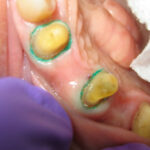
Increased demand in aesthetic dental restoration requires dentists to work with high precision around the junction between periodontal tissues and restorations such as crowns or veneers. The aim is to produce an aesthetic and natural result where the junction between the restoration and the natural tissues is not visible. Unfortunately, if the fit is not optimized and the adaptation is unsatisfactory, complications can occur such as accumulation of biofilm, secondary caries and inflammation of the periodontium. Different techniques have been established in order to offer gingival displacement during impressions for these restorations in order to obtain the optimal margins impression for the best fit.
The aim of this review is to compare gingival displacement with conventional cords and cordless techniques and determine the reliability of the measurement methodologies.
Methods
Searches were conducted in the Medline/PubMed, Web of Science core collection and Scopus databases by 2 independent reviewers. Clinical studies comparing gingival displacement performed with the cordless technique and gingival displacement performed with mechanical or mechanochemical technique with displacement cords. The selected studies required a human population, with evaluation of gingival displacement on either vital or non-vital incisors, canines, premolars or molars and the outcome of interest being the sulcular width.
Two reviewers independently extracted data and assessed quality using the Cochrane risk of bias tool. Studies were compared using different group analysis depending on the methodology for measurement of the sulcular width such as gypsum cast sulcular evaluation or impression material sulcular width evaluation. Therefore, 14 group analysis were conducted including a global one of all the selected studies.
Results
- 9 studies were included, 2 of them have used random sequence generation.The 9 studies showed high risk of bias.
- The aim of the 14-group analysis consisted in comparing the two techniques (cordless vs cord) but also the comparing which methodology for measuring the sulcular width was most appropriate for each type of gingival displacement technique.
- The majority of studies have shown that the cord technique was more effective for gingival displacement (7 studies) against cordless technique (2 studies) with meta-analysis showing a mean difference MD = 0.11 (95%CI; 0.01 – 0.21).
- The use of digital microscope images obtained from sectioned gypsum cast was the most effective methodology for measuring width displacement compared to impression material displacement measurement or direct intra oral displacement measurement.
Conclusions
The authors concluded:-
The cord technique resulted in increased displacement when compared with the cordless technique […] Evaluation of the sulcular width with a digital microscope image obtained from a sectioned gypsum cast is an adequate and versatile experimental methodology for measuring displacement.
Comments
The authors have searched 3 major databases, preregistered the review protocol on PROSPERO and aimed to follow the PRISMA guideline for reporting systematic reviews. Unfortunately, the majority of the selected studies show a high risk of bias with only two studies using ‘random allocation’ and none having ‘blinding of outcome assessment’ which could have probably been made possible with the use of casts. Particularly as the authors indicate they were an effective method of assessing displacement. The heterogeneity of the meta-analysis was high due to the lack of reproductivity in terms of selection criteria in the different studies selected. The findings suggest that the sulcus width displacement is increased with cord technique compared to cordless technique. It also offers a comparison between the methodology for recording width displacement, with a preference for evaluation of sulcular width with a digital microscope image obtained from a sectioned gypsum cast.
A previous blog (Dental Elf – 1st Oct 2015) based on another systematic review had suggested that the cord technique was indeed more effective for gingival displacement but was also more traumatic for patients and less user friendly to the operator.
Links
Primary paper
Other references
Dental Elf – 1st Oct 2015
Dental Elf – 24th Aug 2016
Gingival retraction methods and their impact on gingival health?
Photo Credits
By DRosenbach at en.wikipedia – Own work (DRosenbach) Transferred from en.wikipedia to Commons by User:Magnus Manske using CommonsHelper., Public Domain, Link
